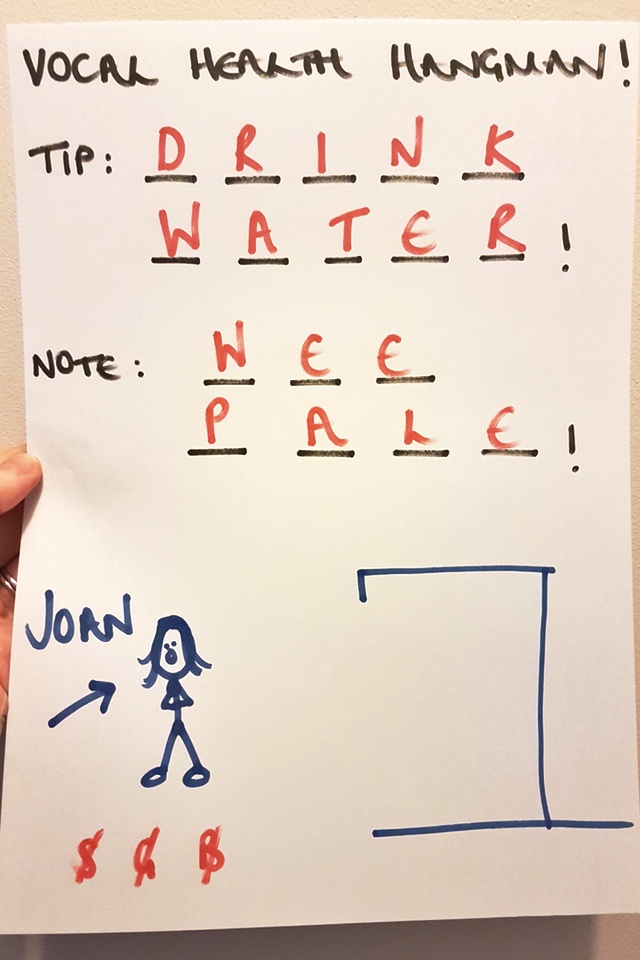Imagine this: 10-year old Sally Simpson arrives at our studio for a singing lesson; she argues loudly with her twin brothers between bites of a chocolate muffin and bouts of throat clearing. She bounds into the room like an excited puppy dressed in a football kit and grass stains on her knees, detailing the multiple parties she has attended in the last two weeks (which makes us question the existence of our own social life). We are about to begin when Sally realises she has forgotten her water bottle and shouts through layers of door and wall for her Mum to fetch it from the car.
Water bottle now in hand, Sally begins to sing the repertoire she has learned and we notice both visible and audible effort; the body is tensing, neck muscles are bulging and the sound is restricted and strident.
So, how might we begin to work with Sally?
‘It’s Elementary, my dear Watson…’
Donning our Deerstalker hats we can begin to pull clues from the information we have so far to help us formulate a plan of action:
- Yeller: Sally Simpson has what Dr Reena Gupta may describe as a ‘nodular personality’, with a speaking voice used at consistently loud volumes.
- Grub Selection: The choice of chocolatey snack could be a food trigger causing the persistent mucous shifting and thus irritating the vocal cords.
- Outfit: Dressed in gym gear we can note that sport is another hobby Sally enjoys where shouting is taking place.
- Visible & Audible Effort: Used to making a loud sound, Sally may be compensating something lacking or weak in the singing voice with unnecessary bodily tension and grip.
- Chest Voice Dominant and Head Voice Resistant: The strident and ‘yelly’ sound can point us in the direction of a ‘chest-heavy’ voice with, perhaps, some fear of the unfamiliar upper range. Also known as TA (Thyroarytenoid muscle) Dominant
1.Improving Vocal Health
It’s no secret that children can be loud. In her book ‘Teaching Singing to Children and Young Adults,’ Jenevora Williams says: “Voice disorders are surprisingly common among school age children… If children have voice problems, poor singing technique is rarely the only cause. The voice problem is nearly always a result of over-use or misuse elsewhere.”
Therefore, we could begin by guiding Sally into forming better vocal health habits, helping her to refrain from loud talking as a default and reduce the amount of unnecessary shouting. We can also educate her about food triggers (which can invite the Mucous Clan to party in our larynx), along with other general tips regarding hydration and voice use during exercise. However, reeling this list of information off our tongues seems unlikely to stick, so finding a fun way to communicate it may help deliver it more lastingly.
Vocal Health Hangman:
Finding new ways to infuse fun into our lessons and keep the singer engaged in the topic can be tricky, but also allows us to be creative as teachers. One successful strategy for me was my reinvention of the retro game ‘Hangman,’ which I now use to teach vocal health tips in a fun way – especially to children and young adults. It can be used in both 1-1 and group sessions, and equally favours the 4 VARK learning preferences.
Caveat: Consider the singer’s age for an idea of general literacy ability, and understand if there are any learning difficulties, such as dyslexia, before introducing this game.
How do you play?
The teacher draws a set of dashes on a whiteboard or sheet of paper collectively spelling out a vocal health tip and a way in which we can implement it into our daily lives; the singer(s) has to guess the letters to create the correct words in order to save a stickman character’s voice (thank goodness for the stickman: art is not my forte!)

2. Primal Sounds
Sally probably doesn’t realise it, but she has likely used her upper range in times of excitement or in play and imitation.
Renowned voice coach and researcher Janice Chapman has developed an holistic method of teaching which includes the use of emotive sounds embedded within our primal state as humans. In an interview with Doug Beck published by speechpathology.com, Chapman says: “The importance of primal sound in the singer is that is helps awaken the connections between the emotional motor system and the voice. It contains the “human expression” in sound which truly communicates emotions and ideas to the outside world. In the singer it becomes the unifying factor which makes singing feel both easy and potent.”
To help Sally release from the chest voice dominant coordination and become more familiar with her upper range, we can have some fun with primal sounds and connect them to something relatable. For example, excitement for an upcoming birthday could be met with a few WOOHOOs, imagining a rollercoaster ride could be married with a WEE! sound, and noticing a friend across the street could impel us to call out a YOOHOO!
I like to add a game element to this exercise too, which is especially helpful to singers fearful of entering the upper range and who could benefit from as sense of distraction (plus – it’s fun!)
Primal Sounds Ball Game:
The teacher takes a squishy ball (a stress ball, for example) and stands opposite the singer. If you are working with groups you can arrange them in a circle facing inwards. The singers throw the ball across to each other but, each time the ball is thrown, the singer has to call out a WHOOP, a WEE, a YOOHOO or a COOEE sound. If the singer drops the ball there is a forfeit whereby they have to continue the game one knee. If they drop it again, they will have to sink to both knees – and so on, until they are sat on the floor with one hand behind their back, and are then out of the game. This is always met with laughter and the singers tend to forget they are even using their top notes: they are too busy trying to win!
3. Making Healthier Loud Sounds
Sally clearly enjoys making a loud sound but, currently, it’s not being executed favourably. Therefore, we can help Sally to make big noises in a healthier way by using bright, bratty or witchy sounds, otherwise known as: Twang.
In his youtube series ‘Dr Dan’s Voice Essentials’, Australian based contemporary voice specialist Dr Dan states: “Twang is one of the most important foundational skills a student singer can learn because it helps to create vocal tract shapes that are highly efficient. The efficiency of twang is so high that research has shown that some users of twang can achieve up to 600% more volume with no extra effort… Essentially, the clear, focused resonance of twang helps your voice to work smarter – not harder.”
Sally doesn’t need to know the mechanics behind reducing the aryepiglottic space (even the word makes me need a nap!) We can simply get her calling out sounds such as HEY, MEOW and NEH with a twangy quality which we can pitch up and down the range, executing them with relatable, imaginative intent.
4. Movement & Distraction
Movement can be exceptionally helpful when it comes to relieving some unnecessary tension. Some instructions might include:
- Turning the head from side to side
- Rotating the shoulders
- Hula Hooping Hips
- Marching on the spot
- Picture Drawing
Not only does it have its uses as a distraction tool, but movement can help to unstick a static position, improve bodily awareness, give muscle groups a different job to do and help us to identify the potential source(s) of tension.
With some of these ideas explored we can wave Sally off and lock up the studio each week, knowing that our plan of action is helping her find a less yelly, more released and healthy way of singing. As we know, not all exercises will work for every voice as each singer is individual, so it would be great to hear how you approach working with your ‘Sally Simpsons’.
If you have any other suggestions, questions or comments you can find me and the BAST Trainers in the BAST Facebook Group. To join click button below.




